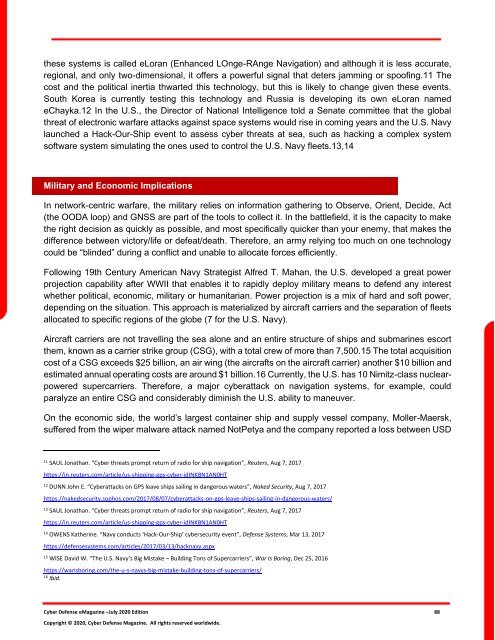Cyber Defense eMagazine July 2020 Edition
Cyber Defense eMagazine July Edition for 2020 #CDM #CYBERDEFENSEMAG @CyberDefenseMag by @Miliefsky a world-renowned cyber security expert and the Publisher of Cyber Defense Magazine as part of the Cyber Defense Media Group as well as Yan Ross, US Editor-in-Chief, Pieruligi Paganini, Co-founder & International Editor-in-Chief, Stevin Miliefsky, President and many more writers, partners and supporters who make this an awesome publication! Thank you all and to our readers! OSINT ROCKS! #CDM #CDMG #OSINT #CYBERSECURITY #INFOSEC #BEST #PRACTICES #TIPS #TECHNIQUES
Cyber Defense eMagazine July Edition for 2020 #CDM #CYBERDEFENSEMAG @CyberDefenseMag by @Miliefsky a world-renowned cyber security expert and the Publisher of Cyber Defense Magazine as part of the Cyber Defense Media Group as well as Yan Ross, US Editor-in-Chief, Pieruligi Paganini, Co-founder & International Editor-in-Chief, Stevin Miliefsky, President and many more writers, partners and supporters who make this an awesome publication! Thank you all and to our readers! OSINT ROCKS! #CDM #CDMG #OSINT #CYBERSECURITY #INFOSEC #BEST #PRACTICES #TIPS #TECHNIQUES
Create successful ePaper yourself
Turn your PDF publications into a flip-book with our unique Google optimized e-Paper software.
these systems is called eLoran (Enhanced LOnge-RAnge Navigation) and although it is less accurate,<br />
regional, and only two-dimensional, it offers a powerful signal that deters jamming or spoofing.11 The<br />
cost and the political inertia thwarted this technology, but this is likely to change given these events.<br />
South Korea is currently testing this technology and Russia is developing its own eLoran named<br />
eChayka.12 In the U.S., the Director of National Intelligence told a Senate committee that the global<br />
threat of electronic warfare attacks against space systems would rise in coming years and the U.S. Navy<br />
launched a Hack-Our-Ship event to assess cyber threats at sea, such as hacking a complex system<br />
software system simulating the ones used to control the U.S. Navy fleets.13,14<br />
Military and Economic Implications<br />
In network-centric warfare, the military relies on information gathering to Observe, Orient, Decide, Act<br />
(the OODA loop) and GNSS are part of the tools to collect it. In the battlefield, it is the capacity to make<br />
the right decision as quickly as possible, and most specifically quicker than your enemy, that makes the<br />
difference between victory/life or defeat/death. Therefore, an army relying too much on one technology<br />
could be “blinded” during a conflict and unable to allocate forces efficiently.<br />
Following 19th Century American Navy Strategist Alfred T. Mahan, the U.S. developed a great power<br />
projection capability after WWII that enables it to rapidly deploy military means to defend any interest<br />
whether political, economic, military or humanitarian. Power projection is a mix of hard and soft power,<br />
depending on the situation. This approach is materialized by aircraft carriers and the separation of fleets<br />
allocated to specific regions of the globe (7 for the U.S. Navy).<br />
Aircraft carriers are not travelling the sea alone and an entire structure of ships and submarines escort<br />
them, known as a carrier strike group (CSG), with a total crew of more than 7,500.15 The total acquisition<br />
cost of a CSG exceeds $25 billion, an air wing (the aircrafts on the aircraft carrier) another $10 billion and<br />
estimated annual operating costs are around $1 billion.16 Currently, the U.S. has 10 Nimitz-class nuclearpowered<br />
supercarriers. Therefore, a major cyberattack on navigation systems, for example, could<br />
paralyze an entire CSG and considerably diminish the U.S. ability to maneuver.<br />
On the economic side, the world’s largest container ship and supply vessel company, Moller-Maersk,<br />
suffered from the wiper malware attack named NotPetya and the company reported a loss between USD<br />
11<br />
SAUL Jonathan. “<strong>Cyber</strong> threats prompt return of radio for ship navigation”, Reuters, Aug 7, 2017<br />
https://in.reuters.com/article/us-shipping-gps-cyber-idINKBN1AN0HT<br />
12<br />
DUNN John E. “<strong>Cyber</strong>attacks on GPS leave ships sailing in dangerous waters”, Naked Security, Aug 7, 2017<br />
https://nakedsecurity.sophos.com/2017/08/07/cyberattacks-on-gps-leave-ships-sailing-in-dangerous-waters/<br />
13<br />
SAUL Jonathan. “<strong>Cyber</strong> threats prompt return of radio for ship navigation”, Reuters, Aug 7, 2017<br />
https://in.reuters.com/article/us-shipping-gps-cyber-idINKBN1AN0HT<br />
14<br />
OWENS Katherine. “Navy conducts ‘Hack-Our-Ship’ cybersecurity event”, <strong>Defense</strong> Systems, Mar 13, 2017<br />
https://defensesystems.com/articles/2017/03/13/hacknavy.aspx<br />
15<br />
WISE David W. “The U.S. Navy’s Big Mistake – Building Tons of Supercarriers”, War Is Boring, Dec 25, 2016<br />
https://warisboring.com/the-u-s-navys-big-mistake-building-tons-of-supercarriers/<br />
16<br />
Ibid.<br />
<strong>Cyber</strong> <strong>Defense</strong> <strong>eMagazine</strong> –<strong>July</strong> <strong>2020</strong> <strong>Edition</strong> 88<br />
Copyright © <strong>2020</strong>, <strong>Cyber</strong> <strong>Defense</strong> Magazine. All rights reserved worldwide.


















